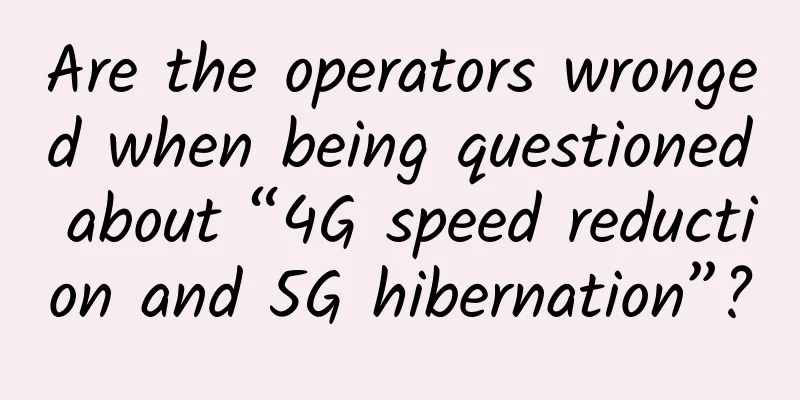Are the operators wronged when being questioned about “4G speed reduction and 5G hibernation”?

|
Recently, a piece of news about "Luoyang Unicom's dormant 5G base stations to reduce energy consumption" has attracted widespread attention. Is 5G construction too fast and excessive? Will dormant 5G base stations affect user use? These have become issues of great concern to all walks of life.
In fact, in addition to the topic of 5G, a large number of netizens have reported that the speed of 4G network is slowing down, questioning whether operators deliberately restrict 4G network in order to promote 5G. Faced with external doubts, operators have protested their injustice. What is the truth behind this? Why do 5G base stations go into hibernation periodically? It is reported that Luoyang Unicom has recently started the deep sleep function of the ZTE 5G base station radio frequency unit equipment (AAU) that has been connected to the network at different time periods in the no-load state, so as to achieve the purpose of energy consumption control of intelligent base station equipment. This news caused a stir on the Internet. "I bought a 5G package. Will this affect my 5G signal?" "If that's the case, why build so many 5G base stations?" Many netizens asked. So far, China Unicom has not commented on this matter. But in fact, the construction of 5G base stations and the substantial increase in power consumption have always been a headache for the three major operators, including China Unicom. According to the public data of the three major operators, the 5G capital expenditures of China Mobile, China Unicom and China Telecom in 2019 were 24 billion yuan, 7.9 billion yuan and 9.3 billion yuan respectively; and in 2020, the 5G capital expenditures of the three are expected to increase to 100 billion yuan, 35 billion yuan and 45.3 billion yuan respectively. The budgets of each company have doubled year-on-year. The significant increase in the budget is closely related to the high cost of 5G construction. At the end of 2019, Li Zhengmao, former vice president of China Mobile and current general manager of China Telecom, bluntly stated in public that 5G development faces three major problems: Since 5G has a higher frequency and shorter wavelength than 4G, the number of 5G base stations must be three times that of 4G to achieve the signal coverage level of 4G; because of the higher frequency, the power consumption of 5G base stations will be three times that of 4G base stations; and the construction cost of 5G base stations is also three times that of 4G. According to this rough calculation, from the perspective of power consumption alone, for 5G networks to reach the coverage level of 4G, operators will have to pay 9 times the cost of electricity in the 4G era. According to previous public information, the annual electricity cost of a single operator is in the tens of billions of yuan, and the three operators together may cost hundreds of billions. Of course, the power consumption cost of base stations is only part of the electricity cost, but it will still add a lot of expenses to operators who are facing pressure to increase revenue and profits. In addition to the high cost, another important reason is that the scale of 5G users has not yet reached the ideal number. According to data from the Ministry of Industry and Information Technology, as of the end of June this year, the three operators have built and opened 400,000 5G base stations across the country. However, in terms of 5G users, the three operators' 5G package users have exceeded 100 million, while only 66 million use 5G phones and 5G networks. This means that some users are using 5G phones but using 4G networks, and some use 4G phones but have opened 5G packages. According to the above figures, there are currently an average of 165 5G mobile phones connected to each 5G base station, which can be said to be a very low utilization rate. This is also the reason why Luoyang Unicom adopts the dormant method. In fact, Luoyang Unicom is not the only one doing this. Communication equipment manufacturers such as Huawei and ZTE have been working hard to reduce power consumption at the 5G base station equipment level and provide solutions for the three major operators. Take Huawei as an example. It has specially launched an energy-saving solution called PowerStar. Through AI and other technologies, it realizes coordinated scheduling of 2G, 3G, 4G and 5G multi-frequency networks to achieve the purpose of energy saving. Ding Yun, president of Huawei's Carrier BG, once explained the principle of this solution to media including Sina Technology. By letting AI learn and judge, it can intelligently analyze and shut down some frequencies in a certain period of time based on the network and business conditions in a certain area, thereby reducing the network power consumption of the entire area to a very low level without affecting the network experience. Although some frequencies were turned off, Ding Yun emphasized that this was done without affecting user use. "This technology is not about good configuration, but about AI technology and judging the environment. For example, when there is a natural disaster, even if there are not many users, we dare not turn off our 5G base stations. For example, during holidays, who dares to turn off the base station at 1 a.m.? At that time, we would like to turn them all on." Telecom analyst Fu Liang also believes that the deep sleep of base stations is not the same as the turning off of street lights. There is no strict timetable. The premise of sleep is that the current equipment is not in use or the business volume is below a certain value. Therefore, the sleep of Luoyang Unicom's 5G base stations has almost no impact on users. Has 4G speed been slowed down? At the same time as the 5G base station dormancy controversy, many users also questioned whether the 4G network is gradually slowing down. A China Telecom user said that he has recently felt that the 4G network speed is much slower than before. "Sometimes sending WeChat messages is abnormal, and some web pages have to be clicked many times before entering. It is almost the same as the previous 2G and 3G." Tencent PR Director Zhang Jun also said on Weibo recently, "There are two problems with mobile phones recently. One is that the 4G network has become very slow; the other is that it crashes frequently." Some users also questioned whether the three major operators were deliberately reducing the speed of 4G in order to promote 5G packages while 5G was being built on a large scale. In fact, as early as 2019, there were rumors of 4G speed reduction. At that time, the three major operators denied it, saying that they had never received any request to limit the speed of 4G, nor had they ever restricted the 4G speed of users. However, with the explosive growth of traffic, hot spots during peak hours may cause some users to have poor connections and reduced speeds. The Ministry of Industry and Information Technology also held talks with the three major operators at the time, requiring them to continue to maintain and transform the 4G network and protect the legitimate rights and interests of users. Wen Ku, director of the Information and Communications Development Department of the Ministry of Industry and Information Technology, said that the Ministry of Industry and Information Technology has built a nationwide monitoring platform to monitor the 4G network speed through technical means. Monitoring shows that the average 4G download speed in the country has continued to increase in recent years, and there has been no significant decline in the speed overall. However, he also admitted that the 4G network is a shared network, shared by all users in the area, and the speed will fluctuate within a range. The network experience speed will also be affected by many factors including the number of users, traffic scale, website visits, etc. For example, in places with dense users such as train stations and concerts, the experience speed may temporarily drop. A communications industry analyst also gave a different opinion. He believes that operators have already invested a large amount of their budget in 5G construction under the condition of limited financial resources, which has led to a decline in investment and operating expenses in 4G networks. Since 4G users still far exceed 5G users, this will inevitably increase the pressure on existing 4G networks and reduce users' experience on 4G networks. Another trend is that with the large-scale development of 5G construction, operators are gradually clearing out 2G and even 3G networks to free up spectrum resources and reduce operation and maintenance costs. In the process of clearing out 2G and 3G networks, users should be guided to migrate to 4G, which further increases the number of users and traffic volume carried by 4G networks. For various reasons, it is not surprising that some users feel that their 4G network speed is decreasing. How to get out of this dilemma? "4G speed reduction, 5G hibernation" may be due to some users' misunderstanding of the operator's services, but operators also need to strike a balance in the cycle of transitioning from 4G to 5G to ensure user experience. During his tenure at China Mobile, Li Zhengmao once said that while building the 5G network, China Mobile would not easily give up the 4G network, and 4G and 5G would coexist for a long time. In fact, this is very applicable to all three major operators. According to the 5G user targets previously announced by the three major operators, China Mobile's goal this year is to develop 100 million 5G users, while China Telecom aims to achieve 60-80 million 5G users this year. Even if fully achieved, the proportion of 5G users in the overall user base is still not high, and 4G users still account for the majority. As number portability continues to advance, it is extremely important for the three major operators to continuously encourage their existing 4G users to upgrade to 5G, rather than switching to other operators due to network quality issues. In July this year, the number of Chinese number portability users exceeded 10 million, and more than 40% of them did so to obtain better network coverage and network signals. To manage the existing 4G users well, the operators need to develop good strategies and services. To reduce the construction and operation costs of 5G, the entire communications industry, including the operators, must solve this problem. Ding Yun believes that operators need to invest precisely in 5G construction and spend money where it counts. He once gave an example that in the early stages of 5G network construction, the main target should be users who can afford 5G mobile phones. For example, in the site selection of 5G base stations, we must first consider whether the community has high-value users and whether the population density of the community is high enough. "For example, a 5G mobile phone costs 3,500 yuan. If the mobile phones in a community are all 1,000 yuan or 2,000 yuan users, this is not the place we should plan and build in the early stages." Secondly, we should select sites based on the requirements of the industry and the government, so that operators can quickly get a return on investment and have higher investment efficiency. In terms of reducing the power consumption of 5G base stations, in addition to operators and communication equipment manufacturers reducing power consumption in equipment and networks, some operator executives have also publicly called on local governments to introduce preferential policies for 5G base station electricity consumption. Since 2019, local governments in many provinces and cities have introduced corresponding measures to accelerate the development of 5G. Most of them mentioned the need to promote the reduction of electricity costs for 5G base stations, and some places even provided subsidies for electricity use of 5G base stations. However, the above-mentioned communications industry analyst pointed out that in order to fundamentally cover the 5G construction and operation costs, operators still have to rely on the large-scale popularization of 5G users. "These 5G users include both C-end and B-end." He said. At present, 5G industry applications on the B side are being implemented, but it will take some time before they can be put into large-scale commercial use and bring real revenue to operators; on the C side, the biggest obstacle is that killer applications have not yet been born. "There are still too few targeted 5G applications, which leads to many users not feeling the difference between 5G and 4G in their experience." He said that with the acceleration of 5G deployment, the entire industry needs to focus on developing some new applications that can reflect the value of 5G and differentiate 4G and 5G, so as to attract consumers. |
<<: How to use SSL/TLS in Node.js
Recommend
QinQ basics, VLAN double-layer TAG, learn in one minute
1. Introduction to QinQ The VLAN ID field defined...
How to efficiently implement scheduled tasks in Redis
Redis uses a single thread combined with a non-bl...
External tools connect to SaaS mode cloud data warehouse MaxCompute practice
This sharing will be explained from four aspects....
RAKsmart: San Jose dedicated server limited flash sale starting at $30/month, optional premium network or CN2 line
RAKsmart is a foreign hosting company operated by...
CloudCone: Los Angeles CN2 GIA line server 15-100M unlimited traffic starting from $82/month
I have shared information about CloudCone many ti...
Is your online office software a helper or a killer?
Zoom, the leading video conferencing company, wit...
How will operators charge in the 5G era? IT leaders say...
2019 is the first year of 5G commercialization. S...
Cisco will focus on the small and medium-sized enterprise market, Cisco Designed provides preferred services
[51CTO.com original article] Enterprises have alw...
What are the excellent designs worth learning in NS?
I used to be a student, and now when I think back...
Experts in Cyber Threat Response in the Digital Age | Weibo Online Officially Announces Brand Upgrade
Recently, on the occasion of its seventh annivers...
Tongmingzhi Cloud "appeared" at the 2022 Information Technology Independent Innovation Summit Forum and released the Loongson 3C5000-based application delivery gateway
Recently, the 2022 Information Technology Autonom...
7 Industries That Will Be Revolutionized by the Internet of Things
What kind of revolutionary impact will the Intern...
[11.11] Maxthon Hosting: 25% off on all VPS, top up 111 yuan and get 111 yuan free, US CN2/Hong Kong CN2/Germany CN2/Netherlands CN2/Hong Kong High Defense, etc.
Maxthon Hosting has released this year's Doub...
RackNerd: Multi-room AMD Ryzen+DDR4+NVMe series VPS is available for purchase starting at $14.18 per year
RackNerd is a foreign hosting company founded in ...
Computer Network Architecture
[[416546]] The formation of computer network arch...









